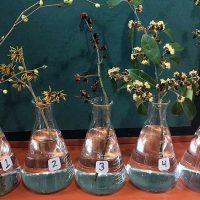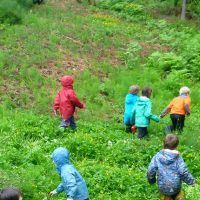Our 2020 Northwest Flower and Garden Festival Display: “Gateway to a Greener Earth”

The following ex-situ conservation plants are all listed as endangered in their region of origin due to habitat loss and climate change:
1) Araucaria araucana Monkey Puzzle
This unique looking conifer is native to the Chilean Andes and considered a living fossil dating back over 60 million years.
The Mapuche Pehuenche people of the Andes value these trees for their edible seeds and spiritual significance.
All About Hamamelidaceae: The Witch Hazel Family

1) Corylopsis glabrescens Fragrant Winter Hazel
Corylopsis are Asian natives which bloom in late winter or early spring with profusions of sunny yellow flowers dangling from bare branches.
Corylopsis glabrescens is the hardiest of the genus and can grow up to 15 feet high and wide.
Flower buds are about to burst open on this shrub in the Witt Winter Garden.
February 2020 Plant Profile: Cotoneaster salicifolius

Intrepid plant hunters suffered a bit to bring back seeds of this glorious Chinese shrub to grow in the Arboretum.
Read moreSelected Cuttings from the Washington Park Arboretum

1) Abies pinsapo var. marocana
This fir is native to Morocco, where it occupies a small area in the mountains south of Tetuan.
Not as tall as the type, this variety has needles similar to A. pinsapo but are wider and longer.
Located along the Arboretum Loop Trail, just south of parking lot #19.
2) Cunninghamia konishii
Cunninghamia is a genus of just three species native to northeastern Asia.
Read moreAmeriCorps Assistant Farm Manager – Adam’s Story of Service

My name is Adam, and I’m an Americorps member serving as the Assistant Farm Manager at the University of Washington Farm. The UW Farm is a two acre student-powered farm located across three sites with varying scales, challenges, and opportunities. At our largest site at the Center for Urban Horticulture, we demonstrate productive market gardening, while at the Mercer Court dormitory complex we model how farming can fit into urban environments.
Read moreBeyond An Outdoor School: Nurturing A Child’s Nature-Connection

While we are all on-board with getting kids outside more often and less bonded to screens, many people see the benefits of an outdoor education but don’t necessarily have the schedule flexibility or the financial means to send their kids to a nature-based program.
Getting out on the weekend can be tough too, especially in the winter. This is what it looks like in my house…
Me: Let’s go to this cool trail this weekend!
AmeriCorps Environmental Programs Steward – Chloe’s Story of Service

My name is Chloe, and I am serving at the University of Washington Botanic Gardens through AmeriCorps and Washington Service Corps. Before I go into the duties of my specific position, I’d like to give a brief explanation of what it means to serve as an AmeriCorps member. AmeriCorps members often find themselves recruiting volunteers and promoting active community engagement to better serve their local neighborhood.
Read moreJanuary 2020 Plant Profile: Trees with Ornamental Bark

As we approach winter and the leaves are off the deciduous trees, we have an opportunity to see the forms of trees and their bark. Some tree barks are just gorgeous and really add to a landscape’s appeal.
Read moreNew Selected Cuttings Welcome the New Year to the Washington Park Arboretum

1) Illicium henryi Henry’s Star Anise
Native to China, this pungent plant is related to culinary star anise (Illicium verum). Specimens can be found on the Sino-Himalayan hillside and along the western edge of the Magnolia Collection.
The genus name Illicium comes from the Latin for “allurement” or “inducement from an enticing scent”. This refers to the aromatic scent released by bruised or crushed leaves.
Winter Interest at the Washington Park Arboretum

1) Edgeworthia chrysantha Paperbush
Native to China, the inner bark of this plant may be used to make quality paper.
The silvery flower buds will open in mid-winter to very fragrant, creamy-yellowish flowers.
Edgeworthia can be found on the west side of the Graham Visitors Center in the Pacific Connections China Garden and the Witt Winter Garden.
2) Hamamelis vernalis ‘Christmas Cheer’ Witch Hazel
This witch hazel is native to the Ozark Plateau.
Read more